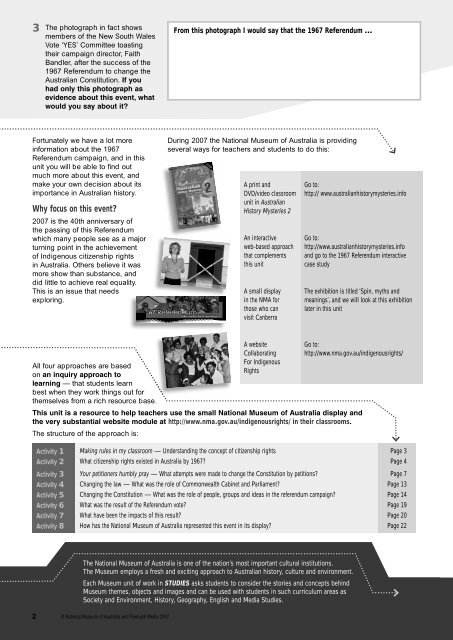The 1967 Referendum (PDF 1.4 MB) - National Museum of Australia
The 1967 Referendum (PDF 1.4 MB) - National Museum of Australia
The 1967 Referendum (PDF 1.4 MB) - National Museum of Australia
Create successful ePaper yourself
Turn your PDF publications into a flip-book with our unique Google optimized e-Paper software.
3 <strong>The</strong> photograph in fact shows<br />
members <strong>of</strong> the New South Wales<br />
Vote ‘YES’ Committee toasting<br />
their campaign director, Faith<br />
Bandler, after the success <strong>of</strong> the<br />
<strong>1967</strong> <strong>Referendum</strong> to change the<br />
<strong>Australia</strong>n Constitution. If you<br />
had only this photograph as<br />
evidence about this event, what<br />
would you say about it?<br />
From this photograph I would say that the <strong>1967</strong> <strong>Referendum</strong> …<br />
Fortunately we have a lot more<br />
information about the <strong>1967</strong><br />
<strong>Referendum</strong> campaign, and in this<br />
unit you will be able to find out<br />
much more about this event, and<br />
make your own decision about its<br />
importance in <strong>Australia</strong>n history.<br />
Why focus on this event?<br />
2007 is the 40th anniversary <strong>of</strong><br />
the passing <strong>of</strong> this <strong>Referendum</strong><br />
which many people see as a major<br />
turning point in the achievement<br />
<strong>of</strong> Indigenous citizenship rights<br />
in <strong>Australia</strong>. Others believe it was<br />
more show than substance, and<br />
did little to achieve real equality.<br />
This is an issue that needs<br />
exploring.<br />
During 2007 the <strong>National</strong> <strong>Museum</strong> <strong>of</strong> <strong>Australia</strong> is providing<br />
several ways for teachers and students to do this:<br />
A print and<br />
DVD/video classroom<br />
unit in <strong>Australia</strong>n<br />
History Mysteries 2<br />
An interactive<br />
web-based approach<br />
that complements<br />
this unit<br />
A small display<br />
in the NMA for<br />
those who can<br />
visit Canberra<br />
Go to:<br />
http:// www.australianhistorymysteries.info<br />
Go to:<br />
http://www.australianhistorymysteries.info<br />
and go to the <strong>1967</strong> <strong>Referendum</strong> interactive<br />
case study<br />
<strong>The</strong> exhibition is titled ‘Spin, myths and<br />
meanings’, and we will look at this exhibition<br />
later in this unit<br />
All four approaches are based<br />
on an inquiry approach to<br />
learning — that students learn<br />
best when they work things out for<br />
themselves from a rich resource base.<br />
A website<br />
Collaborating<br />
For Indigenous<br />
Rights<br />
Go to:<br />
http://www.nma.gov.au/indigenousrights/<br />
This unit is a resource to help teachers use the small <strong>National</strong> <strong>Museum</strong> <strong>of</strong> <strong>Australia</strong> display and<br />
the very substantial website module at http://www.nma.gov.au/indigenousrights/ in their classrooms.<br />
<strong>The</strong> structure <strong>of</strong> the approach is:<br />
Activity 1 Making rules in my classroom — Understanding the concept <strong>of</strong> citizenship rights Page 3<br />
Activity 2 What citizenship rights existed in <strong>Australia</strong> by <strong>1967</strong>? Page 4<br />
Activity 3 Your petitioners humbly pray — What attempts were made to change the Constitution by petitions? Page 7<br />
Activity 4 Changing the law — What was the role <strong>of</strong> Commonwealth Cabinet and Parliament? Page 13<br />
Activity 5 Changing the Constitution — What was the role <strong>of</strong> people, groups and ideas in the referendum campaign? Page 14<br />
Activity 6 What was the result <strong>of</strong> the <strong>Referendum</strong> vote? Page 19<br />
Activity 7 What have been the impacts <strong>of</strong> this result? Page 20<br />
Activity 8 How has the <strong>National</strong> <strong>Museum</strong> <strong>of</strong> <strong>Australia</strong> represented this event in its display? Page 22<br />
<strong>The</strong> <strong>National</strong> <strong>Museum</strong> <strong>of</strong> <strong>Australia</strong> is one <strong>of</strong> the nation’s most important cultural institutions.<br />
<strong>The</strong> <strong>Museum</strong> employs a fresh and exciting approach to <strong>Australia</strong>n history, culture and environment.<br />
Each <strong>Museum</strong> unit <strong>of</strong> work in STUDIES asks students to consider the stories and concepts behind<br />
<strong>Museum</strong> themes, objects and images and can be used with students in such curriculum areas as<br />
Society and Environment, History, Geography, English and Media Studies.<br />
2<br />
© <strong>National</strong> <strong>Museum</strong> <strong>of</strong> <strong>Australia</strong> and Ryebuck Media 2007

















